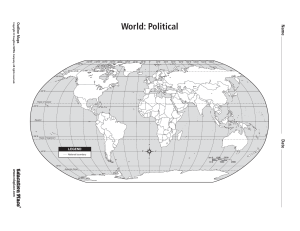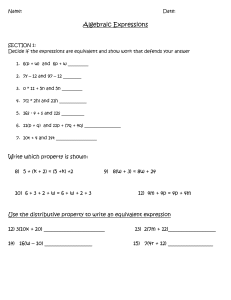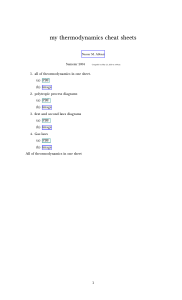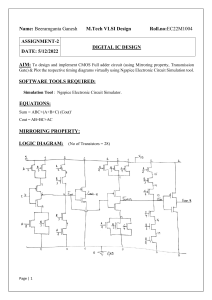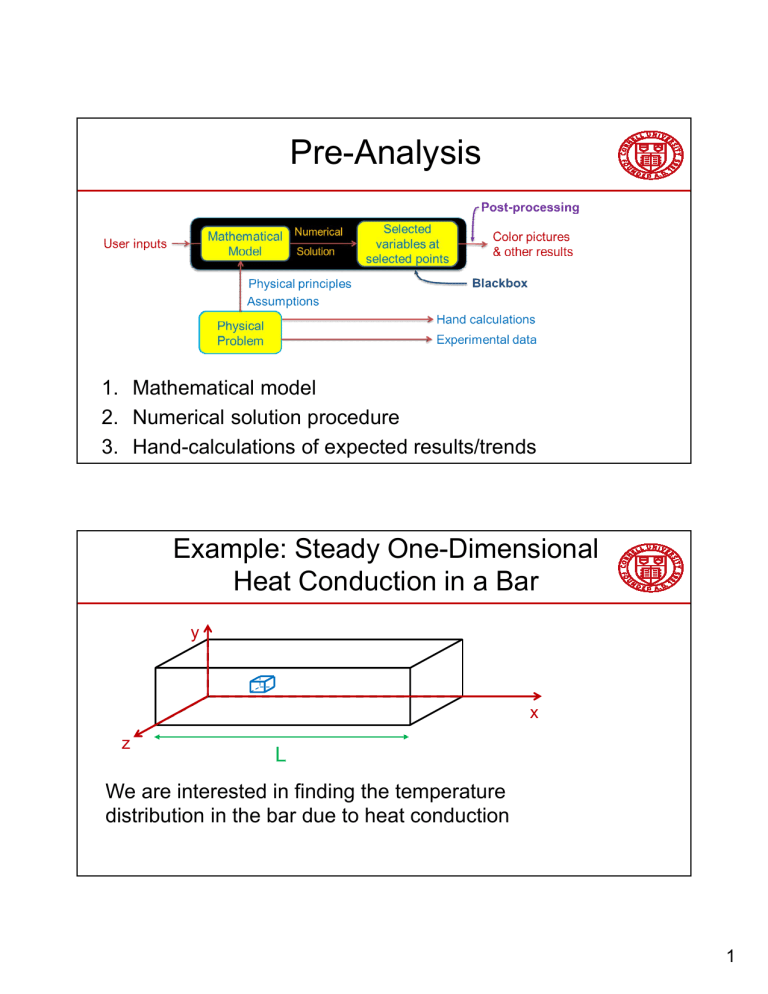
Pre-Analysis
1. Mathematical model
2. Numerical solution procedure
3. Hand-calculations of expected results/trends
Example: Steady One-Dimensional
Heat Conduction in a Bar
y
x
z
L
We are interested in finding the temperature
distribution in the bar due to heat conduction
1
Energy Conservation for an
Infinitesimal Control Volume
Infinitesimal
“Control Volume”
Δ
x
Δ
Δ
Mathematical Model: Governing
Equation and Boundary Conditions
• Governing equation
+
= 0,
0≤
≤
• Boundary conditions
0 =
q L = q = −
• Exact solution is straightforward
2
Numerical Solution:
Discretization
• Reduce the problem to determining temperature
values at selected locations (“nodes”)
T
1
2
3
4
x
x
We have assumed a shape for ( ) consisting of piecewise
polynomials
How to Find Nodal
Temperatures ?
System of
Invert
algebraic
equations in nodal
temperatures
Mathematical Model
(Boundary Value
Problem)
Piecewise
polynomial
approximation for T
1
2
3
={ }
4
Each algebraic
equation will
relate a nodal
temperature to
its neighbors
Nodal
temperatures
Post
processing
( )
3
How to Derive System of Algebraic
Equations?
Piecewise
polynomial
approximation for T
∫
∫
+
=0
+
System of algebraic
eqs. in nodal
temperatures
Piecewise polynomial
approximation for T
Weighted Integral
Form
=0
( ) is an
arbitrary function
+
=0
(x) is an
arbitrary piecewise
polynomial function
System of algebraic eqs.
in nodal temperatures
How to Derive System of Algebraic
Equations?
Piecewise polynomial
approximation for T
∫
+
dx = 0
(x) is an
arbitrary piecewise
polynomial function
System of algebraic eqs.
in nodal temperatures
x
4
Integration by Parts
• ∫
+
• w k
− ∫
∫
=0
w k
2
1
w
w
dT
+
=0
k
+
−
k
3
4
+ 0.5 Δ −
+
=0
+
+
+
+ Δ
+
+
+
+
+
+
+ 0.5 Δ +
Δ
dT
=0
5
w k
dT
2
1
⋯+w
k
w k
dT
+
=0
+
=0
4
3
+
1
−
+ 0.5 Δ +
dT
2
−
k
3
dT
4
6
w k
2
1
w
w
dT
−
k
3
4
+
+ 0.5 Δ −
+
+
+ Δ
+
+
+
+
+
+
+ 0.5 Δ +
dT
+
=0
+
=0
+
Δ
=0
={ }
w k
1
dT
−
2
k
3
dT
4
={ }
7
dT
w k
2
1
w
w
−
k
3
4
+
+ 0.5 Δ −
+
+
+ Δ
+
+
+
+
+
+
+ 0.5 Δ +
w k
dT
Δ
+
=0
+
=0
+
=0
−
k
2
1
dT
dT
3
4
={ }
+
= 0.5 Δ −
+
+
=
Δ
+
+
=
Δ
+
= 0.5 Δ +
8
Essential Boundary Conditions
=T
+
+
+
=
Δ
+
+
=
Δ
+
= 0.5 Δ +
= 0.5QΔ −
Comparison of Finite-Element and Exact
Solutions
• Nodal temperature values are exact
– Unusual property of 1D FE solution
• Temperature boundary condition is
satisfied exactly
• Flux boundary condition is satisfied
approximately
9
Comparison of / between FiniteElement and Exact Solutions
• Error in / > Error in
• Energy is not conserved for
each element
“Reaction” at Left Boundary
=−
=
− 5.5 W/m
• Energy is
conserved for
the bar
10
How to Improve the Polynomial
Approximation?
• Increase no. of elements
• Increase order of polynomial
within each element
Original Mesh
2
1
– Use more nodes per
element
4
3
Refined Mesh
1
2
3
4
5
6
7
Second-Order Element
Error Reduction: Results
3 elements
6 elements
1 element, secondorder polynomial
11
Finite-Element Analysis: Summary of
the Big Ideas
• Mathematical model to be solved is usually a boundary value
problem
• Reduce the problem to solving selected variable(s) at selected
locations (nodes)
• Assume a shape for selected variable(s) within each element
• Derive system of algebraic equations relating neighboring nodal
values
• Invert this system to determine selected variable(s) at nodes
• Derive everything else from selected variable(s) at nodes
Finite-Element Analysis: Summary of
the Big Ideas
• Reduce error by using more elements and/or
increasing the order of interpolation
• Finite-element solution doesn’t satisfy the
differential equation(s)
– Satisfies a special weighted integral form
• Essential boundary conditions are satisfied
exactly
• Natural or gradient boundary conditions are
satisfied approximately
12
